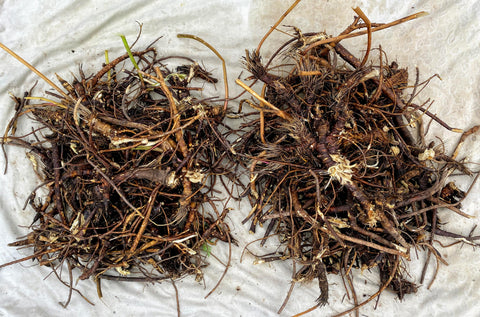Which herbs are effective against Salmonella
Which herbs are effective against Salmonella
May 25, 2021
As I've discussed in a previous post on How to Use Herbal Remedies there are at least 2 basic ways we can approach working with plants as medicine. In today's post, I'm going to look at how we can get very specific with our target action... perhaps at the expense of seeing the bigger picture. Let's get into it.
In the previous post I mentioned that we can use herbal remedies by targeting a specific concern (eg. infectious organism), tissue, or condition. This approach to working with herbs largely comes as a response to modern research into infectious organisms, disease states in the human physiology (pathophysiology), and specific actions (in vitro; ie. in a lab setting, not in humans or animals) of phytoconstituents (the chemical "parts" of a plant).
This is a complex bag as it is an area of research that is inherently in isolation.
Let me explain... Due to our criteria for making statements of a scientific nature, one must go through a certain rigor to show that their has been a reasonable and logical approach to ascertaining this information. In addition to following scientific protocols, of course, there is an inherent need to reduce the whole into parts. This is perhaps the key dividing line between so-called allopathic medicine and holistic medicine. The allopathic approach takes a look at biochemical actions (inhibitory and activating) on the cellular level through the tools and lens of modern science. Through this approach, we can say with some assuredness what's going on in there at the cellular level.
However, one important caveat that is often overlooked and under-appreciated is that the results were obtained under a particular set of conditions which may or may not be replicable at a later date. Ultimately, it really depends on how close the correlation is.
So, when we're looking at herbs that have been found to be "effective against" a particular organism such as, say, Salmonella, we must acknowledge that this is a starting point in terms of our knowledge. Additionally, we may consider were these tests done on humans, human cell lines, animals, in vitro vs. in vivo, etc. That's where our assessment of the overall value of a study comes in as we weigh the relevance of this plant being valuable against a particular microbe or not.
Then there's the school of thought that germ theory is a false view of the etiology and progression of illness and disease in the human body. But let's just leave that aside for the moment because we are, afterall, here to discuss an infectious organism.
Once we've developed our list of "herbs effective against xyz" then we can start looking at these herbs from the perspective of an herbalist. Well, at least I will because that's what I do!
This means that I will evaluate the herbs for potential toxicity in the general population (if formulating for a broad group), or the individual that has sought my assistance, before choosing to administer these herbs. Next, I may consider the constitutional effects of these herbs (2nd point of consideration in my How to Use Herbal Remedies post) on a specific individual, at a given point in time, or how several herbs may work together in a formula.
So, from an herbalist's perspective there are additional layers of subtlety which help build a sophisticated approach to working with herbs for specific infections.
Additionally, an herbalist may not begin with an herb that has been scientifically proven to be effective against said infectious organism, but instead appears useful in assisting this individual with their current physiological or mental/emotional state such that they may be in a better position to heal themselves.
There is yet another level that herbalists may work on (hopefully): Intuition.
This allows one to see from the heart into the situation before them. When this vision is clear, an herbalist can defy logic and reason and go directly to the heart of the matter and provide a most effective and efficient remedy which marshals all available vitality in the most elegant and expeditious manner. This is something that happens between the herbalist and the recipient either through explicit or implicit communication for which the herbalist is responsible for attending to and following wholeheartedly. This is where the magic happens.
But to steer us back into the mundane, let's look at some of those herbs that are effective against Salmonella, shall we?
_______________________________________

Alchornea cordifolia, Christmas bush
Bidens species, tickseed
Cryptolepis sanguinolenta
Glycyrrhiza species, licorice root
Juniperus species, juniper
Ligusticum porteri, Oshá root
Lomatium species, biscuit root
Mahonia species, Oregon grape
Schinus molle, red peppercorn
Sida species, fan petals
Zingiber officinale, ginger

Bidens (no relation to the US president) has been shown effective against a wide array of infectious microorganisms. This plant is exceptionally versatile with significant actions on a wide array of tissues in the human body. Its toxicity potential is quite low as a tea or tincture and can be taken by young children, the elderly, and pregnant women safely, but due to its effects on blood sugar, those on blood sugar lowering medications should be watched closely when large doses (1/2 tsp tincture, or more) are taken or the herb is taken consistently for more than a few days. Much could be said about Sida which also poses a wide array of beneficial actions on the human body including effectiveness against a wide array of infectious agents (viral, bacterial, and fungal). Red peppercorn (Schinus molle) has been shown to inhibit Salmonella growth in beef, so consider adding it as a spice where concern over spoilage is warranted. Oshá root essential oil has been tested against infectious organisms, including Salmonella. Interestingly, it was found to be synergistic with cipro- floxacin and tetracycline against Salmonella.
Oregon grape is a fundamental herb for all GI infections (eg. food poisoning). A tea is best, or at least an extract that involves a fair amount of water as berberine (a potent alkaloid found in Mahonia species which is responsible for much of its antimicrobial activity) is mostly soluble in water, and it remains in the gut - it’s not for systemic infections. Licorice root is an important remedy in all therapuetics for Salmonella infections (pharmaceutical as well) as it is a synergist which potentiates the whole regimen.
A dosage range for the primary herbs such as Cryptolepis, Sida, Bidens, or Alchornea might be 1 tsp to 1 Tbl, 3-6x/day. Licorice root can be added to this formula, or can be taken in a secondary immune support formula along with oshá root and ginger. Fresh ginger juice can also be beneficial, as well as the tea or tincture.
If available, make a tea of juniper leaves (and a couple berries) and/or Sida species to drink daily. Oregon grape root may be best used as a tea, or the tincture could be added to Sida, Bidens, etc formula.
Note that if only 1-3 of these herbs are available, that can be a fair treatment in itself. It will not be necessary to all of the above herbs, but utilizing a variety of herbs often has the best effect.
In severe cases, where sepsis sets in, add dan shen (Salvia miltiorrhiza) and/or dang gui (Angelica sinensis); echinacea and red root (Ceanothus species) tinctures, 60 drops & 90 drops per hour, respectively, may also be of great benefit.
I hope you find this to be a useful guide for approaching Salmonella infections, aka food poisonings.


Leave a comment